- Title: Avenger
- Platform: Turbo CD (PC Engine CD)
- Developer: Telenet Japan
- Publisher: Laser Soft
- Release: December 7, 1990 (Japan only)
Intro
The Turbo CD is a great, and important, console. Designed by Hudson and sold by NEC, it was the first ever CD-based gaming platform when it released in Japan in 1988. While I love cartridges too, that is an important advance. I finally got my Turbo CD drive repaired in late summer 2013, and the system has been my most-played TV console since then. This is the first Turbo CD game I finished (Alzadick aside, but that’s a special case), so it got my first full review. The Turbo CD is awesome. I wish more Western gamers in general knew about its greatness. The TG16+CD, or PC Engine and PCE CD as they were known in Japan, have some dedicated fansites, but very little awareness outside of that hardcore base. Given the system’s low sales in the West, and thus low availability here, that is sadly unlikely to change, but it should. Anyone who likes 3rd or 4th gen gaming really should play more Turbografx! It’s really good.
Background
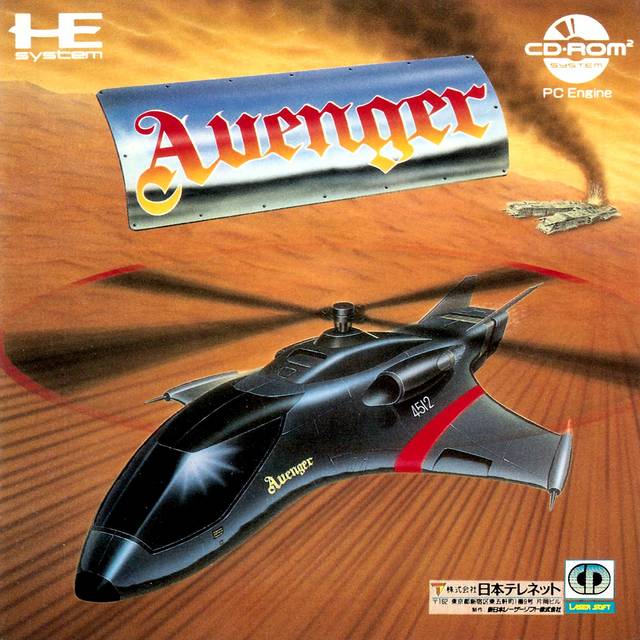
The box does a good job of showing what the game is like.
Avenger is a shmup from Laser Soft, which was one of Telenet Japan’s many divisions, along with Riot, Reno, Renovation, and Wolf Team. Telenet supported the Genesis and SNES as well, but while they did make cartridge games, they were also an early pioneer in CD gaming. From 1989-1994, they supported the Turbo CD and then Sega CD as well. Telenet was the first third party to support the Turbo CD, which was the first ever CD-based gaming platform. However, several years later, Telenet fell apart. By 1995 Telenet was collapsing; Wolf Team was bought by Namco (they became Namco’s Tales Studio). Renovation, their American publishing arm which had focused almost exclusively on Genesis and Sega CD games, was bought by Sega. At the time they were just starting to support the SNES, so they released only one SNES game. Renovation never supported the Turbografx, sadly. Too bad. NEC released a few of Telenet’s TG16/CD games, most notably Valis II and III, but Avenger, like most of their games, stayed Japan-only. The rest of Telenet either shut down or became a shadow of its former self, as Telenet itself devolved into being pretty much a gambling games only studio from about 1995 on, and closed in 2007. Looking at their games from their 1989-1994 time as a major console games publisher, Telenet’s games are often flawed, and are not as polished as, say, Nintendo’s, but they made quite a few but while they lasted they made some interesting games.
————-
Review
————-
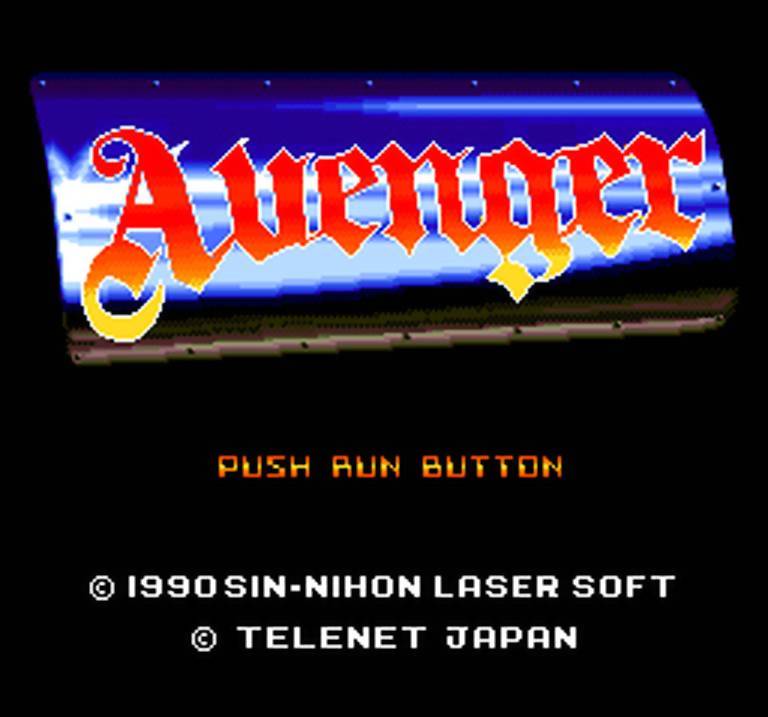
Title Screen
So, on to the actual game. Avenger is not one of Telenet’s more popular releases, for sure, but I at least think that it is an under-appreciated, quite high quality game. This review will cover all major elements of the game, including the gameplay, weapons and upgrades, cutscenes, ingame graphics, options, and music. Lastly, final thoughts and a grade for the game (since I have finished the game, so I think scoring it is reasonable).
Game Design
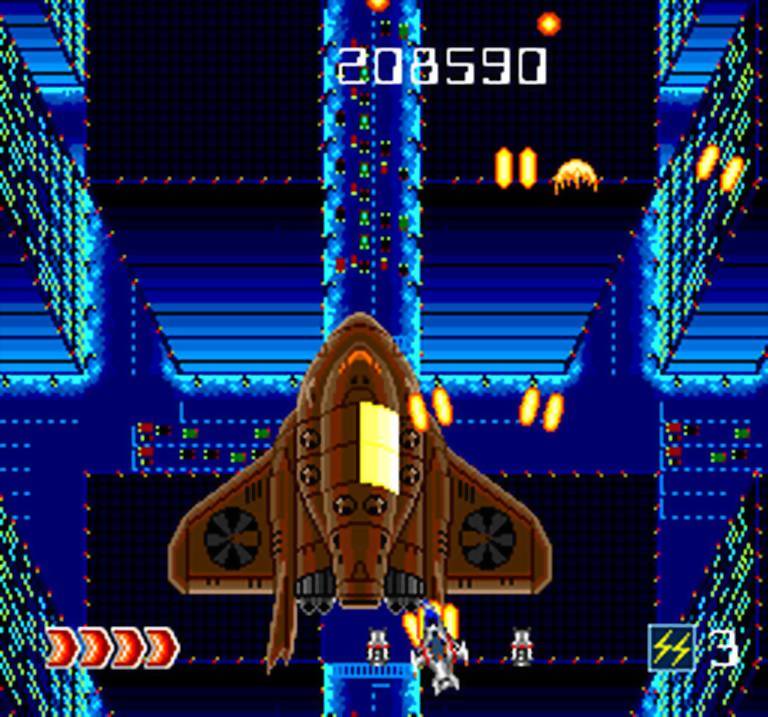
The city level (level 3 or 4) is the best-looking level in the game. Also note the angled fire from your copter.
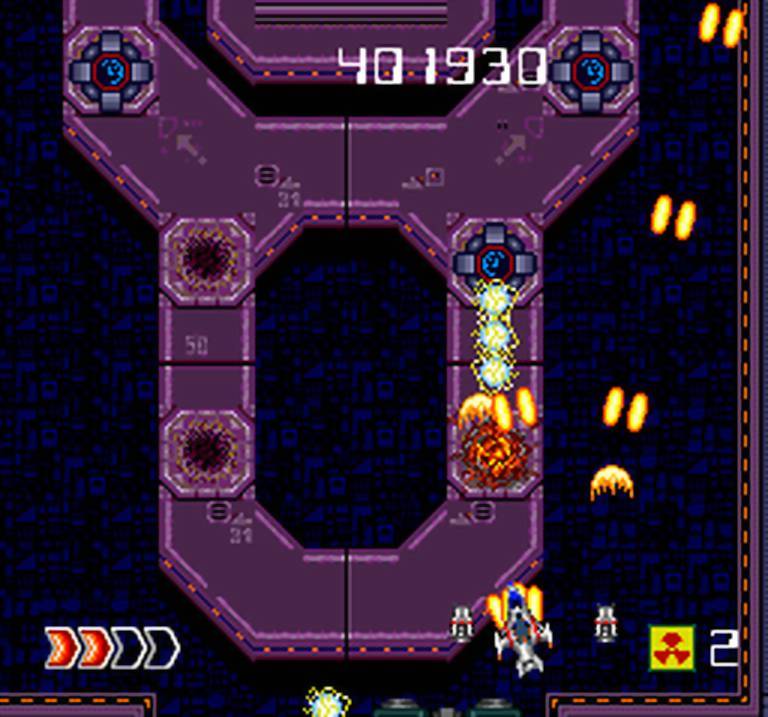
From the last level, this is one of the harder parts of the game, if you’re not at full power… but I did eventually figure out how to get through this corridor safely. Watch those bullet patterns!
Apart from that, though, Avenger definitely feels inspired by Toaplan games and other major ’80s shmups like, perhaps, Raiden, though this is not a “Raiden-style” game like Cyber-Core (TG16) is. The game is a vertical-scrolling shooter, and feels somewhat like Kyukyoku Tiger (Twin Cobra), except not quite as hard, and better looking than that game is. The game has about eight stages, but is somewhat nonlinear — you will play all of the levels every time, but can choose which order to play the middle levels in (2-3, 4-5, 6-7). You choose one or the other, then will go to the other stage next. It’s a minor, but nice, addition. Avenger heavily relies on memorization. Each time you play the game you will get better and learn more, so your first few times through the game might be tough. This isn’t the hardest shmup, though, s stick with it and it is doable. Even so, the game can be challenging in that classic shmup way because of how it demands memorization, and also punishes you for dying. I think the difficulty level is balanced very well, though. This game is not nearly as hard as Kyokyoku Tiger/Twin Cobra, thankfully. I completed the game after some practice, and I’m definitely not the best shmup player around. Overall Avenger isn’t easy, but it’s not super hard either — it’s just right. While many enemies shoot at you, bosses and some certain enemy types shoot preset patterns instead. These are not bullet-hell-impossible, though; with a little practice, and watching, I could figure them out. There are often safe spots in a pattern, so look for them. I like the bullet pattern design in this game for sure. It’s good.
Weapons and Upgrades
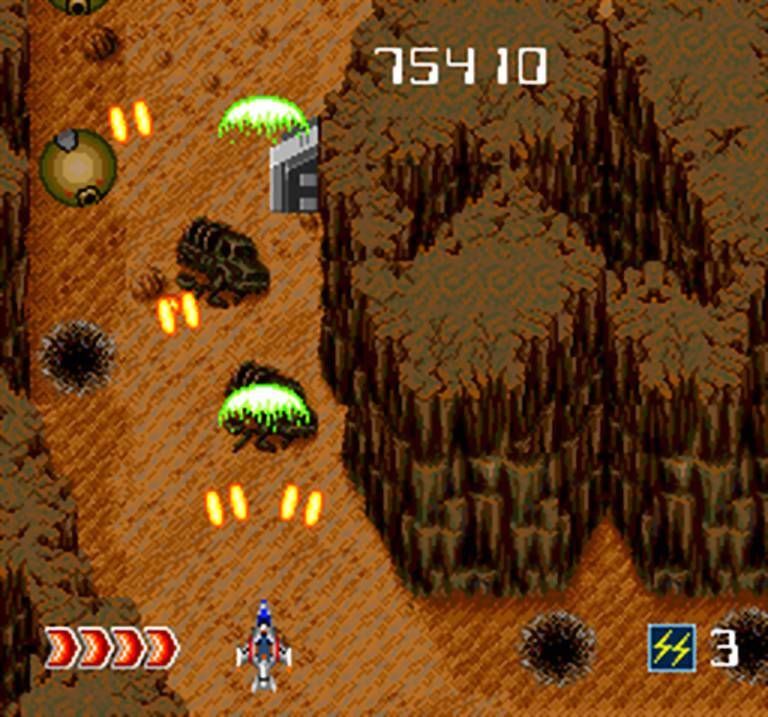
Level 2 or 3, the canyon. Hit the sides and you will blow up! Only some levels have instant-death walls, but this is one of them. So watch out.
Avenger lets you choose which weapon/item you want for each of your copter’s three slots: main weapon, secondary weapon, and special ability. Helpfully, the weapon-select screen is entirely in English, even though the between-mission story text is in Japanese. There are three things you will unlock in each category over the course of the game; at the start you have no choices, but by the end, or if you use that “unlock all weapons from the start” code you can find on GameFAQs and elsewhere, you have some choices for sure. The three main guns are a machine gun, a laser, or rockets. I like the rockets at first, then lasers later, though all three are good. You don’t start with a secondary weapon, but will get homing missiles at the start of the second level, and then later get a directional gun (useless) and side gunpods. I find the homing missiles and gunpods both useful in different levels. For special abilities, you start with one which destroys all bullets on screen (3 uses per level). The other two come much later in the game. One is a one-time-use invincibility item, and the last a two-uses megabomb (finally!). You also have shielding on your copter which can take 5 hits before you are destroyed, which is very handy.
As in Toaplan games, or others, one enemy ship type drops powerups when destroyed. The drop will cycle between different letters. “R” restores one hit point (up to a max of 5). The others upgrade your main weapon and upgrade your special weapon (only appears in level 2 and on). You cannot upgrade or restore your special item, so use them carefully. Your secondary weapon maxes out with only a couple of powerups, but the main gun takes four or five to hit max power, so try to stay alive. If you die, though, you get game over and will have to continue and start the level over. You have infinite continues in Avenger, but can’t save your progress, and this game can get hard at times if you die, due to losing all of your powerups. This is an oldschool game, and getting reverted to base power HURTS. Even though you can take multiple hits, which adds an very helpful margin for error to the game, it’s easy to take damage quickly once the hits start coming. Some skill will be required, though again, the difficulty here is reasonable overall. Tough, but reasonable. Overall, the weapon and upgrade systems are classic, and work well. It is very annoying how once in a while the upgrade icons will fly off the screen before going to the powerup you need, though, so watch them carefully and try to destroy the ships carrying them as far up the screen as you can!
Cutscenes
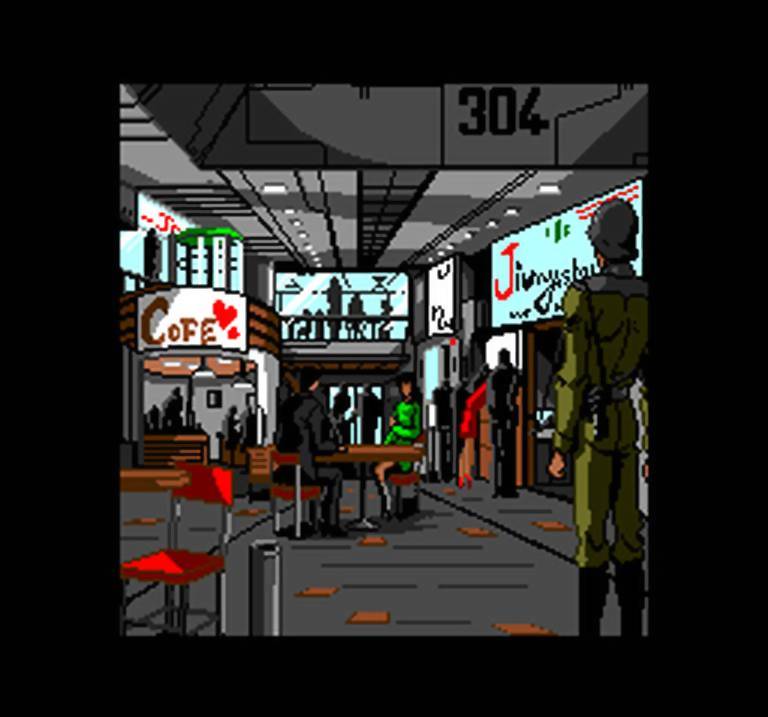
Beginning of the intro. Poor city… it is doomed, just in order to give you a game to play.
This game released in 1990, still in the early years of CD gaming. So, the cutscenes here are important. Telenet did a nice job with the presentation in Avenger. Unlike some early Turbo CD shmups (Legion, Daisenpuu Custom, Sidearms Special…), the game has not only CD-audio music, but also has voiced introduction and ending cutscenes. The voice acting is in Japanese, but the basics of what is going on are simple enough to understand: with our high-tech futuristic helicopter, defeat the badguys attacking your country. Beyond that, apparently the story is about a military commander from your nation who became a traitor and is trying to take a large carrier, which was supposed to be your helicopter’s base, to the enemy. You have to stop him, and the carrier. As with most Turbo CD games the intro and ending are “animated” in a very limited fashion. The Turbo CD has only 64KB of RAM by default, and this game released before the RAM-expanding Super or Arcade Cards, so animation in cutscenes is limited and cutscenes have frequent black screens for loading. Still, the two cutscenes look nice enough.
Options
Avenger has no options or settings, unfortunately. This is a common issue in Turbografx games, and probably comes from NES-era design since most NES games work like that as well. The game does have cheatcodes, but only to let you have all weapons from the start or for invincibility. That first code is nice, though, for trying out after you’ve beaten the game. Beyond that though, all you can do is start playing.
Ingame Graphics
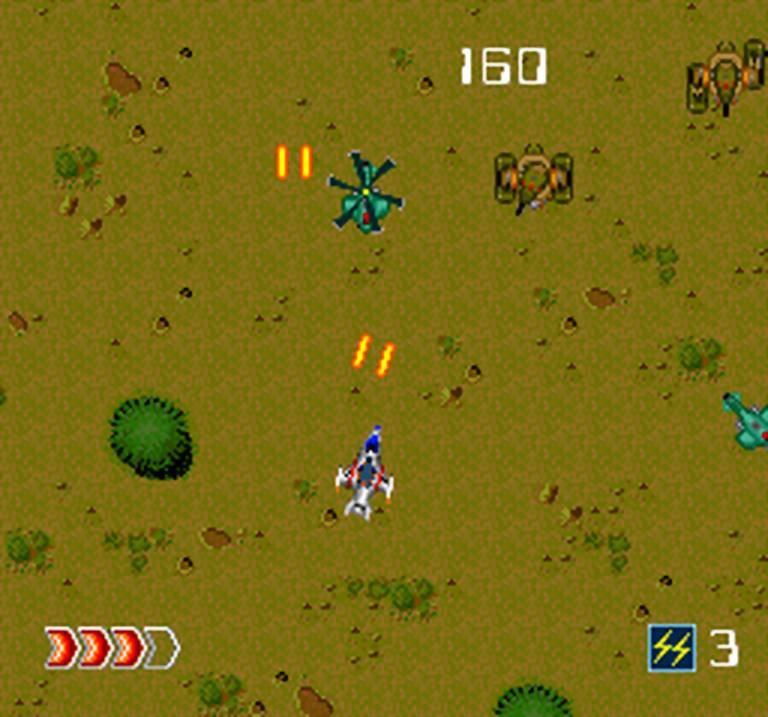
Beginning of the first level. Yes, it looks bland.
Once you get into the game, you see what is perhaps the most-criticized element of Avenger: the bland in-game background graphics. I first played this game, emulated, several years ago, because I heard that it controlled like Under Defeat for the Dreamcast, a game I absolutely love. Well, I saw how bland these graphics look compared to other, later Turbo CD games, and didn’t play this much at all. After finally getting my Turbo CD fixed, though, I made Avenger one of the first import games I bought, because it was something I wanted to play for sure, once I had the actual system. I’m glad I did; the game is fun, despite the mediocre background art, and it’s cheap too.
Once you look beyond the backgrounds, however, Avenger actually looks okay. I think that the ship designs are good, and while the ingame ship graphics aren’t quite at the level of the cinema scene ship graphics, they still look nice. Look at the ship designs in the various screenshots above; This is no Nexzr, for sure, but I think they look okay to good. The various laser bolts and bullets are well-drawn and large as well. I think Avenger gets something of a bad rap for its graphics — play it for more than a couple of minutes and you’ll see that there are some nice things here, graphically. Get beyond the first impression and there is more here. The gameplay is definitely the biggest draw here, but Avenger doesn’t look THAT bad. As I said earlier, the game at least looks quite a bit better than Kyukyoku Tiger’s TG16 port, and some other HuCard shmups besides. The best looking level is definitely the level set in a city at night; that one honestly looks nice. Unfortunately there are a few too many bland desert levels, but still, I think the game looks okay.
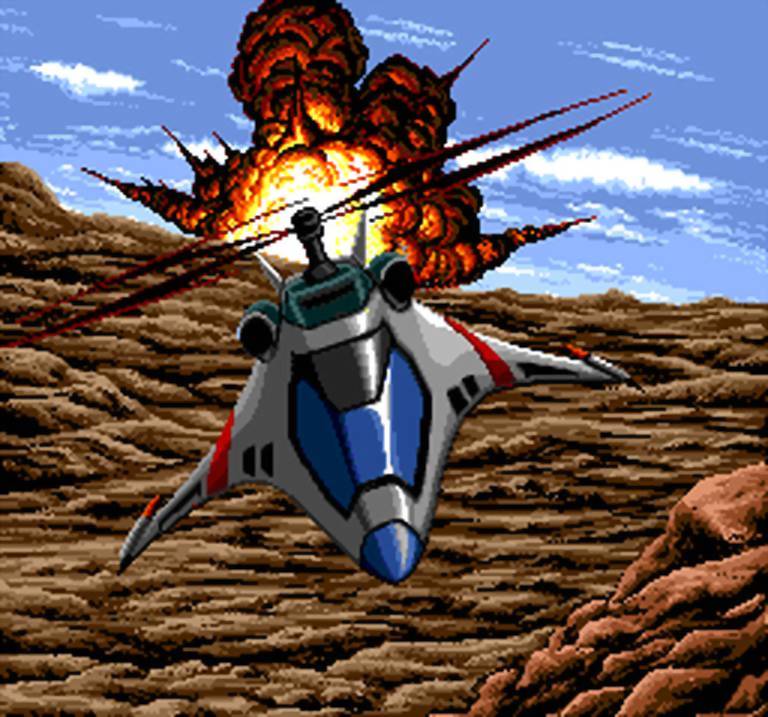
An end-level screen. These are nice. Static, but nice. Each level has a different one.
While there are no cutscenes between the beginning and the end, there are Japanese-language text-only briefings befor missions, and nicely drawn static-image cinema scenes after them, with a fanfare, showing the level you just blasted through. The “game over” screen is also nicely drawn. Looking at reviews of this game these screens receive praise, but the ingame graphics are often harshly criticized. And while it is true that many of the environments are bland, I think that the art design of the ships is pretty good, and levels like the city or final level look decent as well. There are also some interesting boss designs, and nice big flashy lasers sometimes too. Avenger‘s graphics aren’t the greatest, but they are better than some of the critics suggest.
Audio
Avenger has a CD audio soundtrack, and it’s good. I don’t know if I will really remember most of the songs in the game, but some of them are quite nice songs with do a very good job of backing the action and keeping the game more exciting. I like the soundtrack, it’s solid early-game-CD music, and I love this kind of stuff! I will definitely be listening to this soundtrack sometimes in the future. Composers who previously had only worked on sound chips suddenly had access to CDs and could do higher-quality music, but still were often thinking in terms of videogame music. The results are often unique, and it’s really unfortunate that the days of getting such soundtracks passed in favor of generic licensed soundtracks and the like. Well, at least we still have stuff like Avenger. The game doesn’t have one of the best TCD soundtracks, but it does have a solid, good one. The sound effects are average; nothing special, but most games have okay sound effects I think. Overall, the game looks okay and sounds good. Youtube musical selection: http://www.youtube.com/watch?v=RNAYv0z50yk
Final Thoughts
Avenger is a good game that I liked quite a bit. Despite the frustration some of the harder parts of the game induced, I kept coming back to this game anyway until I finished it, which says something for sure! I have probably thousands of games now I haven’t finished, but this is one of the ones I quickly knew I’d be playing to completion. It took a few weeks, but I accomplished that. I am sure that I will replay this game, too — it’s quite fun, and I am certain to play it again, probably in the near future. Avenger may not have the best graphics around, though they are better than, say, Kyuukyoku Tiger (Twin Cobra) on HuCard, but it has addictive, quality gameplay, and the game is well worth playing. I’d highly recommend this to any Under Defeat fan, and recommend it generally as well. This is a solid, fun, under-rated shmup. B+.
https://gamefaqs.gamespot.com/a/screen/full/2/9/2/195292.jpg
Finally, here’s a Youtube LP someone did of the game, for anyone interested in seeing the whole game. http://www.youtube.com/watch?v=JE9SYKDGPMU
